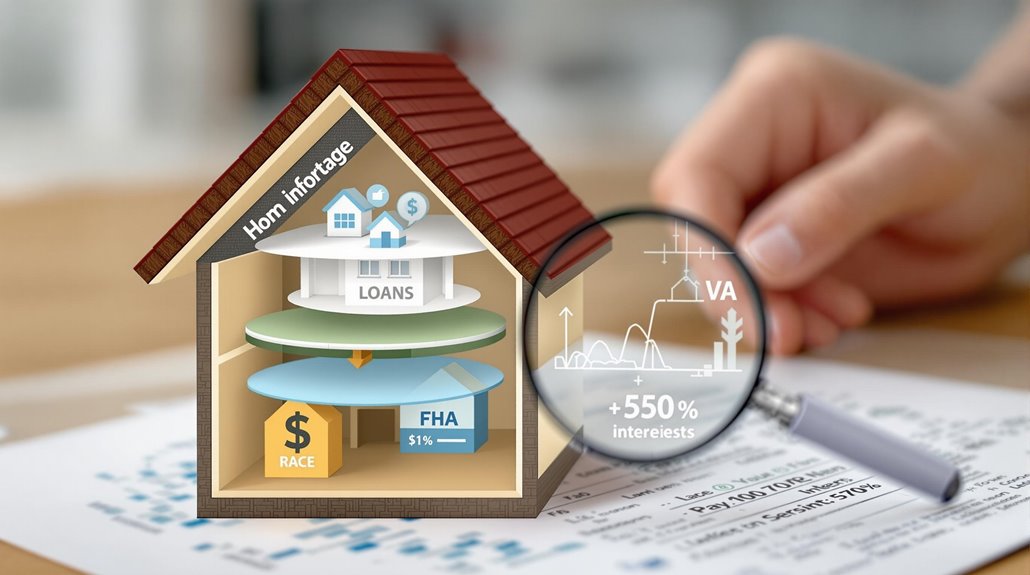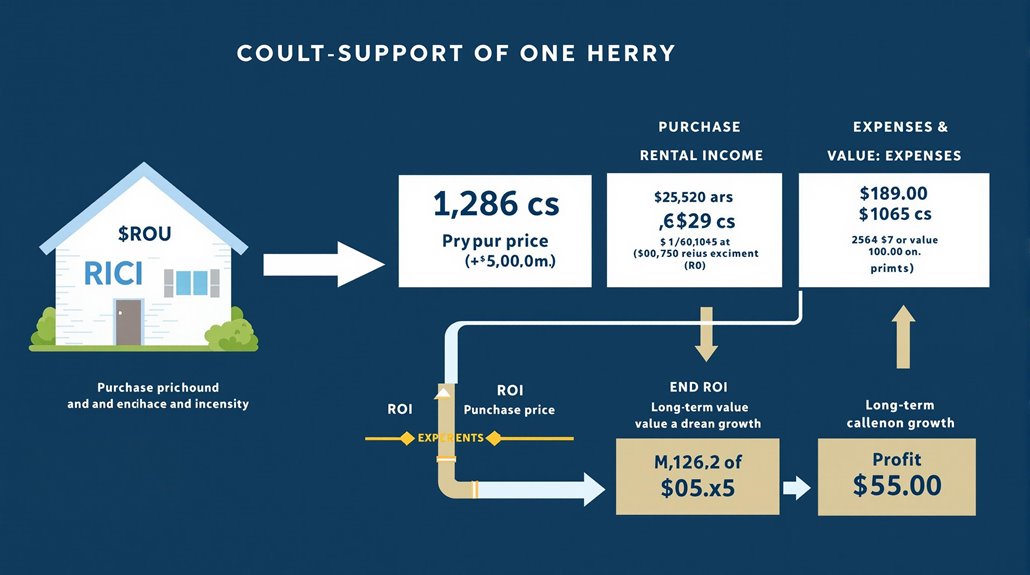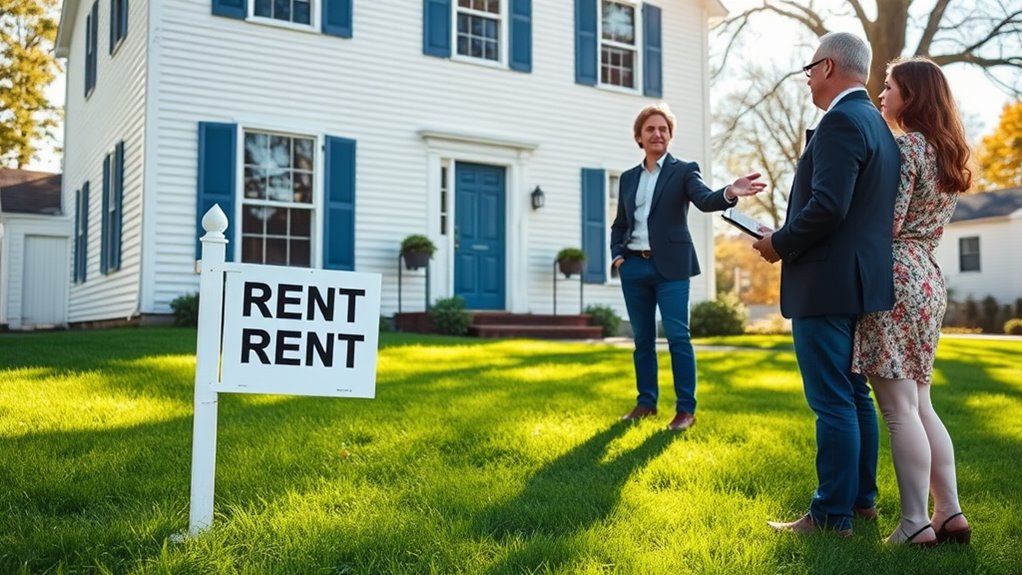Buying a house and renting it out can be a lucrative investment if you’re financially prepared. Start by calculating your debt-to-income ratio and building an emergency fund. Research local rental prices, vacancy rates, and neighborhood amenities to gauge demand. Explore mortgage options and guarantee your credit score meets lender requirements. Factor in property management responsibilities and maintenance costs for accurate ROI projections. Understanding these elements gives you a solid foundation to maximize profitability and minimize risks. Discover more strategies to optimize your rental property investment.
Key Takeaways
- Ensure debt-to-income ratio is 36% or lower for better loan approval chances.
- Maintain an emergency fund covering 3-6 months of living expenses.
- Aim for monthly rent equal to 2% of the property’s purchase price.
- Allocate 1% of the property’s value annually for maintenance costs.
- Verify local market conditions, including vacancy rates and rental demand.
Assessing Your Financial Readiness
Before diving into property investment, you’ll need to thoroughly assess your financial readiness to confirm you’re prepared for both upfront and ongoing costs. Start by calculating your debt-to-income ratio (DTI), aiming for 36% or less to improve mortgage eligibility for buying a house and renting it out. Build an emergency fund covering three to six months’ living expenses, including mortgage payments, to mitigate financial risks. Estimate the total cash investment required, including a 15% to 25% down payment, closing costs, and potential renovation expenses. Don’t overlook ongoing costs like property taxes, insurance, maintenance (around 1% of the property’s value annually), and management fees (8% to 12% of rental income). Finally, check your credit score; most lenders require at least 620, though rates improve considerably with scores above 740. Explore zero-down payment options to minimize upfront costs and maximize your investment potential. Validate your finances are robust before proceeding.
Understanding the Local Rental Market
How can you guarantee your rental property stands out in the local market? When buying an apartment and renting it out, understanding the local rental market is key. Analyze rental prices to make certain they align with your purchase price—aim for rent around 2% of the property’s cost monthly. Investigate vacancy rates; lower rates signal higher demand. Highlight nearby amenities like schools, transit, and shopping to attract tenants. Safety matters—check neighborhood crime stats to confirm renters. Partner with local real estate agents who specialize in rentals for insider market insights. Economic indicators such as employment rates shape rental market health.
- Bustling schools drawing families seeking stability.
- Public transport hubs connecting commuters seamlessly.
- Trendy shopping districts attracting young professionals.
- Safe, well-lit streets fostering long-term tenant commitment.
Focus on these factors to maximize desirability and make certain your rental income stays consistent.
Exploring Financing and Loan Options

Since financing plays a critical role in purchasing a rental property, you’ll need to evaluate your options carefully. How much does it cost to buy a rental property? It depends on your financing approach. Traditional mortgages for investment properties typically require 15% to 25% down payments, and loan options like FHA or VA loans may have different criteria. Ascertain your credit score is at least 620, as rental property loans often have stricter standards. Keep your debt-to-income (DTI) ratio at 36% or lower to improve eligibility. While property management fees (8%–12% of rental income) impact costs, these aren’t directly tied to financing. Explore local down payment assistance programs to reduce upfront expenses. Additionally, private lenders offer quick approval and funding, which can significantly benefit investors needing immediate access to capital. By weighing these factors, you’ll navigate financing options effectively and set a solid foundation for your rental property investment.
Evaluating Property Management Responsibilities
When you invest in a rental property, you’ll need to decide whether to manage it yourself or hire a professional property manager, as both options come with distinct responsibilities and costs. Managing residential rental real estate involves handling tenant screening, lease agreements, rent collection, and maintenance oversight. You must also understand local landlord-tenant laws to navigate lease terms, evictions, and security deposits effectively. Hiring a property management company can reduce your workload but typically costs 8% to 12% of monthly rent. Consider these key factors:
- Tenant Screening: Background checks and credit reviews to secure reliable renters.
- Maintenance: Allocate 1% of the property’s value annually for upkeep.
- Rent Collection: Guarantee timely payments and address late payments promptly.
- Communication: Foster positive relationships to minimize turnover and vacancies.
- Efficiency: Utilize CRM systems to streamline tenant management and enhance operational efficiency.
Weigh the time, costs, and expertise required for each approach to align with your investment strategy.
Calculating ROI and Long-Term Profitability

To maximize the profitability of your rental property investment, you’ll need to accurately calculate its Return on Investment (ROI) and assess its long-term financial potential. If you’re wondering if can you buy a house and rent it out profitably, start by determining your net operating income (NOI). Subtract annual expenses like taxes and maintenance from your rental income, then divide the NOI by your total cash investment. Apply the 2% rule—monthly rent should be 2% of the purchase price—to gauge income potential. Factor in annual maintenance costs at 1% of the property’s value to guarantee realistic projections. Since financing typically requires a 15% to 25% down payment, adjust your ROI calculations accordingly. Positive cash flow is essential; guarantee rental income consistently exceeds monthly expenses like mortgage payments and taxes. Utilizing a Long Term Rental Calculator can streamline this analysis and provide a clearer picture of your investment’s viability. By carefully analyzing these metrics, you can determine whether buying a house and renting it out aligns with your financial goals.
Conclusion
Buying a house to rent out can be a smart investment if you’re financially prepared. Research shows rental properties generate an average 10.6% annual return, outperforming stocks. Focus on understanding your local market, securing favorable financing, and calculating ROI to guarantee long-term profitability. Managing tenants and maintenance requires effort, but outsourcing to a property manager can streamline operations. With strategic planning, you can turn rental income into a reliable revenue stream.




